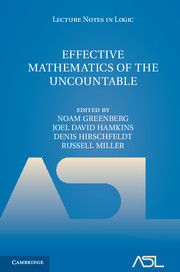Book contents
- Frontmatter
- Contents
- Preface
- Introduction
- Some results on ℝ-computable structures
- Infinite time Turing machines and an application to the hierarchy of equivalence relations on the reals
- Computable structure theory using admissible recursion theory on ω1 using admissibility
- Local computability and uncountable structures
- Borel structures: a brief survey
- E-recursive intuitions
- Reverse mathematics, countable and uncountable: a computational approach
- Effective model theory: approach via σ-definability
- References
Reverse mathematics, countable and uncountable: a computational approach
Published online by Cambridge University Press: 05 December 2013
- Frontmatter
- Contents
- Preface
- Introduction
- Some results on ℝ-computable structures
- Infinite time Turing machines and an application to the hierarchy of equivalence relations on the reals
- Computable structure theory using admissible recursion theory on ω1 using admissibility
- Local computability and uncountable structures
- Borel structures: a brief survey
- E-recursive intuitions
- Reverse mathematics, countable and uncountable: a computational approach
- Effective model theory: approach via σ-definability
- References
Summary
Abstract Reverse mathematics analyzes the complexity of mathematical statements in terms of the strength of axiomatic systems needed to prove them. Its setting is countable mathematics and subsystems of second order arithmetic. We present a similar analysis based on (recursion-theoretic) computational complexity instead. In the countable case, this view is implicit in many of results in the area. By making it explicit and precise, we provide an alternate approach to this type of analysis for countable mathematics. It may be more intelligible to some mathematicians in that it replaces logic and proof systems with relative computability. In the uncountable case, second order arithmetic and its proof theory is insufficient for the desired analysis. Our computational approach, however, supplies a ready made paradigm for similar analyses. It can be implemented with any appropriate notion of computation on uncountable sets.
§1. Introduction. The enterprise of calibrating the strength of theorems of classical mathematics in terms of the (set existence) axioms needed to prove them, was begun by Harvey Friedman in the 1970s (as in [6] and [7]). It is now called Reverse Mathematics as, to prove that some set of axioms is actually necessary to establish a given theorem, one reverses the standard paradigm by proving that the axioms follow from the theorem (in some weak base theory). The original motivations for the subject were foundational and philosophical. It has become a remarkably fruitful and successful endeavor supplying a framework for both the philosophical questions about existence assumptions and foundational or mathematical ones about construction techniques needed to actually produce the objects that the theorems assert exist.
- Type
- Chapter
- Information
- Effective Mathematics of the Uncountable , pp. 150 - 163Publisher: Cambridge University PressPrint publication year: 2013



